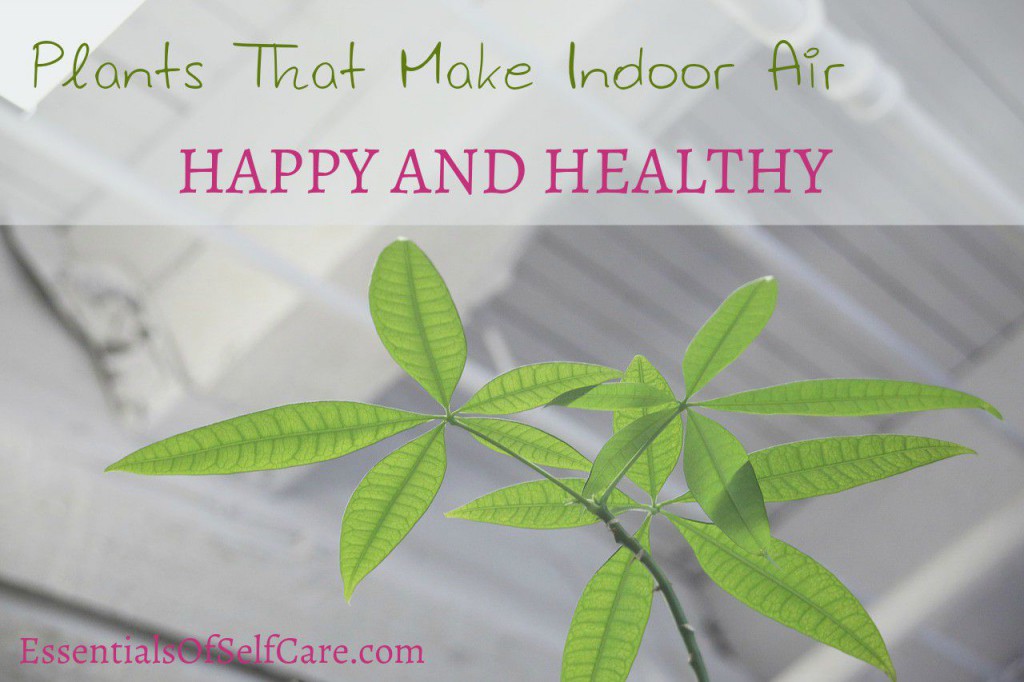
It’s estimated that Americans spend around 90 percent of their time indoors, which I guess if you think about it, is probably pretty accurate. Unless you work outdoors, chances are that between the workplace, home, school, and shopping alone, you are indoors a lot, if not most of the time. Unfortunately nowadays, indoor air is often full of many more pollutants than outdoor air.
The rise of off-gassing from mostly synthetic building materials, finishes, and furnishings, along with the chemicals in personal-care products, household cleaners, and pesticides are common causes of indoor air pollution. How about those molds, other biological fungi, pollen, insects, and pests? And let us not forget about that dander and other “stuff” our beloved furry friends spread all around the house.
The Rise of Allergy-Related Symptoms
Due to the energy crunch in the late 1970’s, buildings began being designed to cut energy costs by maximizing efficiency. The dawn of superinsulation and reduced fresh air exchange introduced some new challenges. Sounded like it made sense, the only problem was that once occupied, workers in these buildings began experiencing allergy-related symptoms such as respiratory and sinus issues, itchy eyes, headaches, skin rashes, and fatigue. Come to find out, the contributing factors were the airtight seal of the buildings and the off-gassing of materials within. Dubbed as “sick building syndrome.”
It turns out, levels of pollutants such as benzene and formaldehyde tend to test at levels many times the maximum allowable limits in new homes. Formaldehyde has been linked to asthma, and along with benzene contributes to the symptoms these workers’ experienced. So, then you wonder, is older better? But then we go back to possible mold and fungi issues from exposure to, and deterioration from the elements over many years.
What We Can Do to Filter Indoor Pollutants
Seems like pretty dreary stuff, but being aware of it can help us focus on what to do to help filter out pollutants, at the very least, in our own homes. Fortunately, one of the ways we can enjoy clean air in our environment is by bringing the outdoors in. We learn about photosynthesis in science class, so we know when plants take in carbon dioxide, they process it into oxygen which helps to purify the air.
Taking it a step further, in the late 1980’s NASA published an interesting study showing that certain plants significantly reduced amounts of pollutants in indoor spaces. Specifically, they tested benzene, TCE (trichloroethylene), and formaldehyde, and let’s just say these chemicals are everywhere in indoor environments, down to grocery bags and toilet paper.
The study found that specific plants improve indoor air quality, and combined with activated carbon filters containing fans, are an integral part of any indoor air solution.
I’m all about clean air. In fact, I’ve mentioned in other posts some things I do in my own home to improve the air quality, such as using himalayan salt lamps, a true HEPA filter with activated carbon filters – which has been a complete life saver after a mold scare we had, and for anyone with allergies and asthma. We also use non-toxic personal-care products, cleaning products, and laundry products.
Seems like a valid reason to add some more plants to the collection, don’t ya think?
12 Plants That Improve Indoor Air Quality
A couple things to keep in mind when considering adding any of these plants to your indoor environment is to maximize air exposure to the plant root-soil area for best filtration, as this was shown to be the most effective area for removing pollutants. And, also to avoid overly moist soil that can promote growth of unhealthy microorganisms or mold.
1. Bamboo Palm (Chamaedorea seifritzii)
Pollutants removed: benzene, TCE (trichloroethylene), and formaldehyde
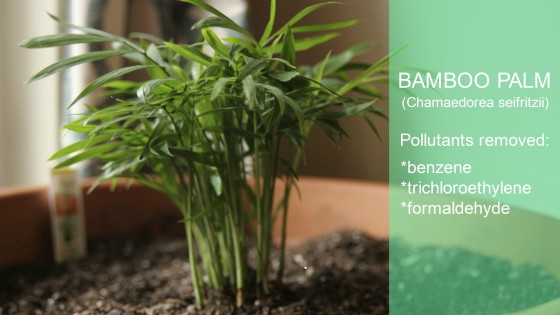
Most tropical palms need bright, indirect light to thrive, with the exception of the bamboo palm. It will grow in low light, just not as tall. It’s fairly low maintenance, and can grow to be 4 to 12 feet in height with a span of 3 to 5 feet. This plant does best without being over watered and with adequate drainage.
2. Chinese Evergreen (Aglaonema modestum)
Pollutants removed: benzene and formaldehyde
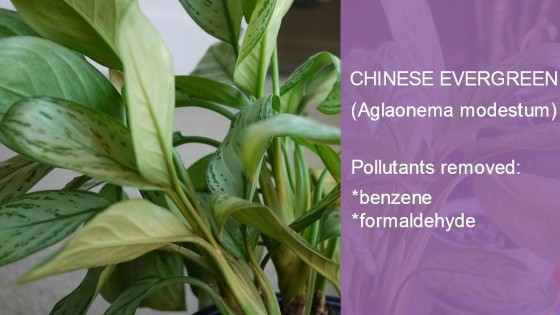
This is a great beginner plant – sturdy, easy to grow, and tolerates just about every indoor condition. It’s slow growing, so it fits well with smaller spaces. It requires low water, doesn’t even need natural light to thrive, and does fine with artificial lighting. This plant also grows well in bright spots.
3. English Ivy (Hedera Helix)
Pollutants removed: benzene, TCE (trichloroethylene), and formaldehyde
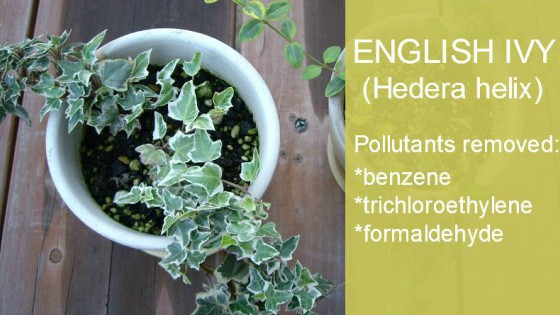
Being a natural climber, ivy grows best indoors in pots with a stake to climb, or hanging baskets. A low maintenance plant, it likes plenty of moisture, especially until well established and growing. Once established it can tolerate drier conditions. It needs bright light, but not direct sun, and thrives in fluorescent lighting. This plant is also said to be a champion when it comes to reducing mold spores.
4. Ficus/Weeping Fig (Ficus benjamina)
Pollutants removed: benzene, TCE (trichloroethylene), and formaldehyde
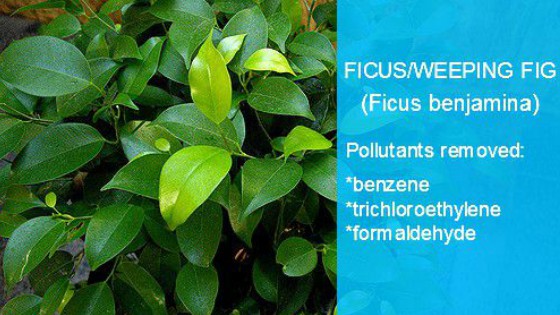
This plant has a tendency to last many years, when it’s well taken care. It’s a slow grower, but can grow to 10 feet indoors. Dwarf varieties reach 3 feet. It does well in bright, indirect light, and thorough watering if allowed to dry out slightly in between. This plant is finicky when it comes to change, such as being moved around to different spots, and doesn’t tolerate drafts from vents, doorways, or soggy soil.
5. Gerbera Daisy (gerbera jamesonii)
Pollutants removed: benzene and TCE (trichloroethylene)
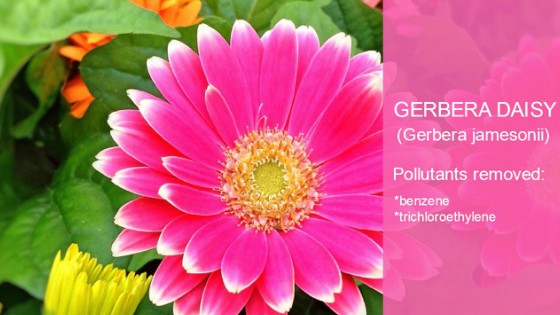
An easy to care for plant that will brighten any indoor area with big velvety flowers ranging in color from pale yellow, soft pink, white to bright oranges, reds, pinks, and purples. Regular varieties can grow to 12 feet, dwarf varieties grow 6-12 inches tall. It does well in bright, direct sunlight, making windowsills a perfect spot. It also likes good air circulation and thorough watering, allowing the top inch of soil to dry out between waterings.
6. Janet Craig (Dracaena deremensis “Janet Craig”)
Pollutants removed: benzene, TCE (trichloroethylene), and formaldehyde
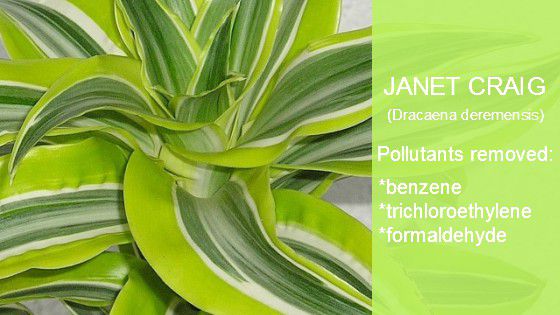
A non-fussy plant that does well if watered thoroughly down to the roots, and then allowed to dry slightly between waterings. It can grow up to 10 feet if not pruned back, and likes moderate to bright light, although direct sunlight will scorch the leaves.
7. Marginata (Dracaena Marginata)
Pollutants removed: benzene, TCE (trichloroethylene), and formaldehyde

Also known as dragon tree, although this plant likes bright light – with the exception of direct sun in summer – it also has the ability to thrive in average indoor conditions, tolerating dry indoor air and low light conditions that most other plants won’t. It’s slow-growing, but can reach 6 feet tall indoors if the top is left untrimmed, and the leaves can grow about 12-16 inches long. It dislikes too much water, prefers light moisture spring through fall, and slightly drier soil during winter.
8. Mass Cane/Corn Cane (Dracaena massangeana)
Pollutants removed: benzene, TCE (trichloroethylene), formaldehyde, ammonia, xylene, and toulene
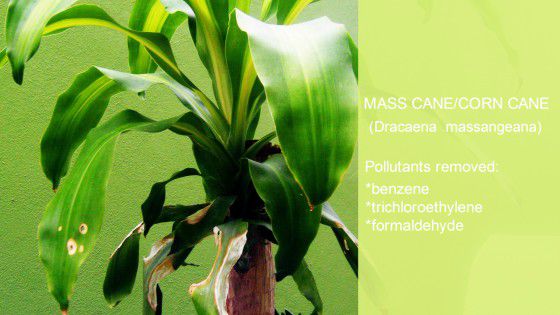
This hardy plant is fairly tolerant if not over watered, provided good drainage, kept away from drafts, and out of direct sun so the leaves don’t get scorched. It’s slow growing, but can reach up to 6 feet, and will live for many years if well taken care of. It likes bright light, but can tolerate low light as well.
9. Mother-in-law’s tongue/Snake Plant (Sansevieria laurentii)
Pollutants removed: benzene, TCE (trichloroethylene), and formaldehyde
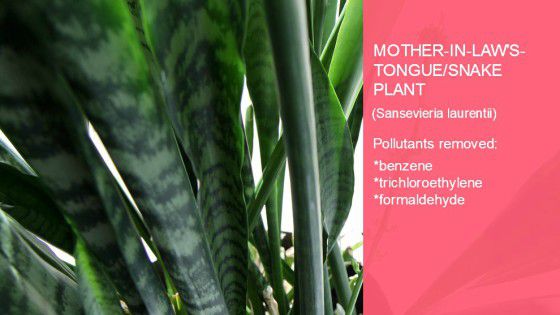
Another great beginner plants, one of the easiest to take care of, this succulent prefers dry air and soil. It’s slow growing, grows to 2 feet and lasts for years, if well cared for. Thrives in bright light to full sun, but will tolerate low light also. Doesn’t like air vents, drafts, or extreme cold.
10. Peace Lily (Spathiphyllum “Mauna Loa”)
Pollutants removed: benzene, TCE (trichloroethylene), formaldehyde, and ammonia
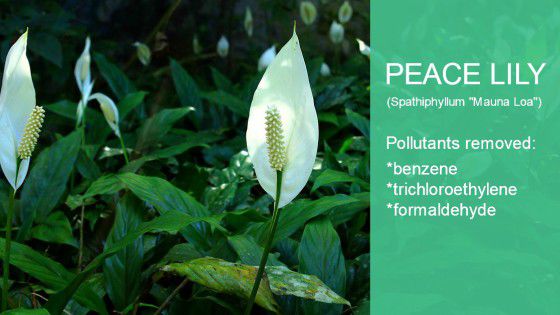
This plant tolerates average indoor conditions, making it one of the easiest indoor flowering plants to take care of. It grows up to 3 feet tall, likes bright light – but not direct sun, and although it may tolerate low light, it won’t bloom properly. It thrives in relative humidity of 40 percent or higher, and likes evenly moist soil with good drainage.
11. Pot Mum (Chrysanthemum morifolium)
Pollutants removed: benzene and formaldehyde
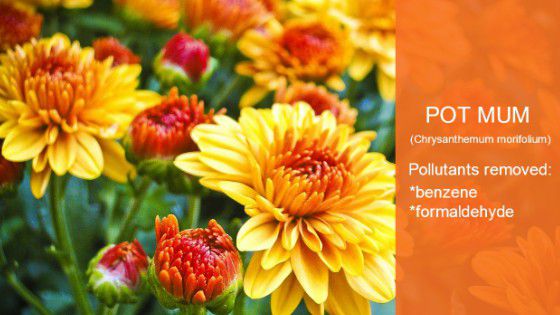
As long as you’re prepared for a short flower cycle (3-4 weeks on average) this plant is fairly easy to find and an inexpensive way to bring some color to your indoor space. After that, you’ll be left with a small bush of foliage. Pot mums like areas with good air circulation, bright light during the day, and regular watering with good drainage.
12. Warneckei (Dracaena deremensis “Warneckei”)
Pollutants removed: benzene and TCE (trichloroethylene)
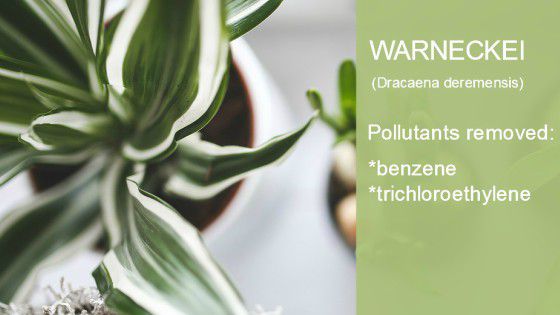
This plant is easy to care for, and can grow up to 12 feet in height. It prefers medium indirect light and will tolerate low light conditions, but the leaves won’t look as deep green. The leaves will scorch if exposed to a lot of direct sunlight. It also likes areas away from vents, or drafts, and dislikes too much water.
A few other plants worth mentioning are the spider plant, the philodendron species, golden pothos, and aloe vera. All are easy to take care of and help to filter indoor air quite nicely.
Conclusion
Plants are an inexpensive and natural way to spruce up the indoors – not only do they bring the beauty of the outdoors in to your environment, add vibrant colors, and create a livelier, or more serene space – they also offer another benefit of nature – improving the indoor air quality we breath so much of, and that’s a great thing!
What are some of your favorite indoor plants? Share below!
